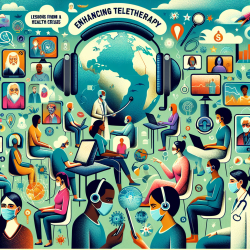Introduction
The COVID-19 pandemic has underscored significant disparities in healthcare access, particularly for socially and economically disadvantaged populations. The research article "Access to Care During a Global Health Crisis" highlights these challenges and provides insights into improving healthcare delivery, including teletherapy, during such crises.
The Teletherapy Advantage
Teletherapy, a crucial component of online therapy services like those provided by TinyEYE, offers a unique opportunity to bridge the gap in healthcare access. The pandemic has accelerated the adoption of telehealth, providing a viable solution for delivering speech-language pathology services to children, especially in underserved areas.
Key Findings from the Research
- Access Disparities: The research highlights how racial and ethnic minorities, particularly those with limited English proficiency, face significant barriers to healthcare access. Teletherapy can mitigate these barriers by providing services directly to the patient's location.
- Telehealth Expansion: The pandemic has catalyzed the expansion of telehealth services, making it a permanent fixture in healthcare delivery. This expansion is crucial for maintaining continuity of care, especially for children who require consistent speech-language therapy.
- Technology Challenges: While teletherapy offers numerous benefits, technology access remains a challenge. Many families lack reliable internet or devices necessary for effective teletherapy sessions. Addressing these technological gaps is essential for equitable service delivery.
Implementing Effective Teletherapy
Practitioners can enhance their teletherapy services by implementing the following strategies:
- Invest in Technology: Ensure that both practitioners and families have access to the necessary technology and support to facilitate effective teletherapy sessions.
- Cultural Competency: Develop culturally competent practices to address the diverse needs of children and families, ensuring that language and cultural barriers do not impede therapy.
- Policy Advocacy: Advocate for policies that support teletherapy reimbursement and access, particularly for underserved communities.
Encouraging Further Research
While the research provides valuable insights, there is a need for further studies to explore the long-term impacts of teletherapy on children's outcomes. Practitioners are encouraged to engage in research initiatives to continually improve teletherapy practices and ensure equitable access to care.
Conclusion
The global health crisis has highlighted the potential of teletherapy to address healthcare disparities. By leveraging technology and implementing data-driven strategies, practitioners can enhance their services and contribute to better outcomes for children. To read the original research paper, please follow this link: Access to Care During a Global Health Crisis.










